A New Approach to Explore the Surface Profile of Clay Soil Using White Light Interferometry
Abstract
:1. Introduction
2. Adhesion–Ploughing Friction Theory
2.1. Basic Concept
2.2. Surface Interaction
2.2.1. Adhesion Effects
2.2.2. Ploughing Effects
- When asperity B (or A) passes through asperity D, asperity D undergoes relatively large plastic deformation and becomes adhesive. If the adhesive strength between the hard and soft medium is greater than the adhesive strength of the soft medium, sliding shear occurs inside the soft medium, making the soft medium transfer from the lower surface to the upper surface (asperity D is ploughed and adhered to the right side of asperity B, even filling asperity B).
- When asperity B (or A) passes through asperity D, it undergoes plastic deformation. If the adhesive strength between the hard and soft medium is smaller than the adhesive strength of the soft medium, the adhesion between the soft and hard medium is not firm (asperity D is ploughed and cannot be adhered to B). Asperity B (or A) ploughs along D, which means cutting along the interface. At this time, material migration and deformation (ploughing) instead of transfer occurs at asperity D.
- Asperity D only produces elastic deformation, and asperity B (or A) slides through D more easily than D produces plastic deformation.
2.3. Adhesion–Ploughing Calculation Formula
3. Discretization of Asperities in a Hard–Soft Interface
4. White Light Interferometry Test of Clay Soil
4.1. Sample Preparation
4.2. Experimental Measurement
4.3. Particle Size Distribution by Laser Measurement
4.4. Profile Data Processing
- A partial section (1500 μm × 1500 μm) in the center of the scanning area (4687 μm × 3516 μm) was selected for analyzing, with a total 45,000 points in this area.
- Horizontal correction was done by the linear fitting of profile data, thereby avoiding the inclination of contour induced from specimen fabrication and placement. The slope was restricted by 2%, which roughly met the experimental requirements.
- Statistics analysis on the point cloud data of Z-direction was conducted by taking 5 μm as an interval. A support point height z0 with the highest distribution frequency was identified regardless of different vertical stress.
5. Discussion
5.1. Actual Contact Plane Location
5.2. The Relationship between Actual Contact Area and Overburden Stress
5.3. Apparent Porosity and Compressive Stress
6. Conclusions
- Under high compressive stress, the real contact area ideally should be the total area of all soil particles in the real contact region (from z0 to z0 + d90), when considering the rebound of the soil particles after unloading, rather than a simple cross-sectional area with a certain height. Hence, compared with the traditional SEM, white light interferometry has an obvious advantage to reveal the real contact area, which would be quite useful in the mesoscopic research of soil particles friction.
- The actual contact area ratio of clay soil is in the range of 0.375–0.431, and the apparent porosity is approximately 0.525–0.554, demonstrating a linear increase with the rise of overburden pressure.
- With an increase of compressive stress, the cumulative frequency of apparent profile height (from z0 − d90 to z0 + d90) has a concentrated tendency with limited value, and a logistic function is used to derive this limit asymptotic value.
- A regression formula for estimating the limit asymptotic value under various initial values was established for clay soil, which provides an experimental basis for the DEM (Discrete Element Method) simulation.
Author Contributions
Funding
Conflicts of Interest
References
- Yang, S.C.; Liu, J.L.; Zhang, M.Y. Analytical solution and field test of critical bearing capacity and settlement of pile tip. Civ. Eng. J. Staveb. Obz. 2020, 1, 61–73. [Google Scholar] [CrossRef]
- Yang, S.C.; Zhang, M.Y.; Wang, Y.H.; Sang, S.K.; Miao, D.Z. Field test on pile tip resistance of closed-end jacked pipe pile penetrating into layered foundation. Rock Soil. Mech. 2018, 39, 91–99. [Google Scholar] [CrossRef]
- Liu, J.W.; Cui, L.; Zhu, N.; Han, B.; Liu, J. Investigation of cyclic pile-sand interface weakening mechanism based on large-scale CNS cyclic direct shear tests. Ocean Eng. 2019, 194, 11. [Google Scholar] [CrossRef]
- Zhu, J.F.; Zhao, H.Y.; Jeng, D.S. Effect of principal stress rotation on dynamic characteristics of a sandy seabed under a partially reflected standing wave. Ocean Eng. 2020, 196, 17. [Google Scholar] [CrossRef]
- Zhu, J.F.; Zhao, H.Y.; Jeng, D.S. Effects of principal stress rotation on wave-induced soil response in a poro-elastoplastic sandy seabed. Acta Geotech. 2019, 14, 1717–1739. [Google Scholar] [CrossRef]
- Zhu, J.F.; Zhao, H.Y.; Jeng, D.S. Dynamic characteristics of a sandy seabed under storm wave loading considering the effect of principal stress rotation. Eng. Geol. 2019, 259, 15. [Google Scholar] [CrossRef]
- Bowden, F.P.; Tabor, D.F. The friction and lubrication of solids. Am. J. Phys. 1951, 19, 428–429. [Google Scholar] [CrossRef]
- Greenwood, J.; Williamson, J. Contact of Nominally Flat Surfaces. Proc. R. Soc. Lond. A 1966, 295, 300–319. [Google Scholar] [CrossRef]
- Prokopovich, P.; Perni, S. Multiasperity Contact Adhesion Model for Universal Asperity Height and Radius of Curvature Distributions. Langmuir 2010, 26, 17028–17036. [Google Scholar] [CrossRef]
- Prokopovich, P.; Perni, S. Comparison of JKR- and DMT-based multi-asperity adhesion model: Theory and experiment. Colloids Surf. A Physicochem. Eng. Asp. 2011, 383, 95–101. [Google Scholar] [CrossRef]
- Petean, P.G.C.; Aguiar, M.L. Determining the adhesion force between particles and rough surfaces. Powder Technol. 2015, 274, 67–76. [Google Scholar] [CrossRef]
- Hanaor, D.A.H.; Gan, Y.; Einav, I. Static friction at fractal interfaces. Tribol. Int. 2016, 93, 229–238. [Google Scholar] [CrossRef]
- Yang, L.; Wang, D.; Guo, Y.; Liu, S. Tribological behaviors of quartz sand particles for hydraulic fracturing. Tribol. Int. 2016, 102, 485–496. [Google Scholar] [CrossRef]
- Nardelli, V.; Coop, M.R.; Andrade, J.E.; Paccagnella, F. An experimental investigation of the micromechanics of Eglin sand. Powder Technol. 2017, 312, 166–174. [Google Scholar] [CrossRef]
- Sandeep, C.S.; He, H.; Senetakis, K. An experimental micromechanical study of sand grain contacts behavior from different geological environments. Eng. Geol. 2018, 246, 176–186. [Google Scholar] [CrossRef]
- Sandeep, C.S.; Senetakis, K. Effect of Young’s Modulus and Surface Roughness on the Inter-Particle Friction of Granular Materials. Materials 2018, 11, 217. [Google Scholar] [CrossRef] [Green Version]
- Sandeep, S.; Senetakis, K. Grain-scale mechanics of quartz sand under normal and tangential loading. Tribol. Int. 2018, 117. [Google Scholar] [CrossRef]
- He, H.; Sandeep, C.S.; Senetakis, K. The interface behavior of recycled concrete aggregate: A micromechanical grain-scale experimental study. Constr. Build. Mater. 2019, 210, 627–638. [Google Scholar] [CrossRef]
- He, H.; Senetakis, K.; Coop, M.R. An investigation of the effect of shearing velocity on the inter-particle behavior of granular and composite materials with a new micromechanical dynamic testing apparatus. Tribol. Int. 2019, 134, 252–263. [Google Scholar] [CrossRef] [Green Version]
- Jeong, S.W.; Park, S.S. Effect of the Surface Roughness on the Shear Strength of Granular Materials in Ring Shear Tests. Appl. Sci. 2019, 9, 10. [Google Scholar] [CrossRef] [Green Version]
- Nardelli, V.; Coop, M.R. The experimental contact behaviour of natural sands: Normal and tangential loading. Géotechnique 2019, 69, 672–686. [Google Scholar] [CrossRef]
- Sandeep, C.S.; Senetakis, K. An experimental investigation of the microslip displacement of geological materials. Comput. Geotech. 2019, 107, 55–67. [Google Scholar] [CrossRef]
- Cundall, P.A.; Strack, O.D.L. A discrete numerical model for granular assemblies. Géotechnique 1979, 29, 47–65. [Google Scholar] [CrossRef]
- Mo, Y.F.; Turner, K.T.; Szlufarska, I. Friction laws at the nanoscale. Nature 2009, 457, 1116–1119. [Google Scholar] [CrossRef] [PubMed]
- Forterre, Y.; Pouliquen, O. Flows of dense granular media. In Annual Review of Fluid Mechanics; Annual Reviews: Palo Alto, CA, USA, 2008; Volume 40, pp. 1–24. [Google Scholar]
- Vakis, A.I.; Yastrebov, V.A.; Scheibert, J.; Nicola, L.; Dini, D.; Minfray, C.; Almqvist, A.; Paggi, M.; Lee, S.; Limbert, G.; et al. Modeling and simulation in tribology across scales: An overview. Tribol. Int. 2018, 125, 169–199. [Google Scholar] [CrossRef]
- Luding, S. Cohesive, frictional powders: Contact models for tension. Granul. Matter 2008, 10, 235–246. [Google Scholar] [CrossRef] [Green Version]
- Wensrich, C.M.; Katterfeld, A. Rolling friction as a technique for modelling particle shape in DEM. Powder Technol. 2012, 217, 409–417. [Google Scholar] [CrossRef]
- Lu, G.; Third, J.R.; Muller, C.R. Discrete element models for non-spherical particle systems: From theoretical developments to applications. Chem. Eng. Sci. 2015, 127, 425–465. [Google Scholar] [CrossRef]
- Kruggel-Emden, H.; Rickelt, S.; Wirtz, S.; Scherer, V. A study on the validity of the multi-sphere Discrete Element Method. Powder Technol. 2008, 188, 153–165. [Google Scholar] [CrossRef]
- Mcdowell, G.; Li, H.; Lowndes, I. The importance of particle shape in discrete-element modelling of particle flow in a chute. Géotechnique Lett. 2011, 1, 59–64. [Google Scholar] [CrossRef]
- Liu, J.; Duan, N.; Cui, L.; Zhu, N. DEM investigation of installation responses of jacked open-ended piles. Acta Geotech. 2019, 14, 1805–1819. [Google Scholar] [CrossRef]
- Thakur, M.M.; Penumadu, D.; Bauer, C. Capillary Suction Measurements in Granular Materials and Direct Numerical Simulations Using X-Ray Computed Tomography Microstructure. J. Geotech. Geoenvironmental Eng. 2020, 146. [Google Scholar] [CrossRef]
- Zhu, J.; Zhu, L.; Zhu, R.; Tian, S.; Li, J. Surface microtopography of surfactant modified montmorillonite. Appl. Clay Sci. 2009, 45, 70–75. [Google Scholar] [CrossRef]
- Desbois, G.; Urai, J.L.; Hemes, S.; Brassinnes, S.; De Craen, M.; Sillen, X. Nanometer-scale pore fluid distribution and drying damage in preserved clay cores from Belgian clay formations inferred by BIB-cryo-SEM. Eng. Geol. 2014, 179, 117–131. [Google Scholar] [CrossRef]
- Omrani, E.; Tafti, A.P.; Fathi, M.F.; Moghadam, A.D.; Rohatgi, P.; D’Souza, R.M.; Yu, Z.Y. Tribological study in microscale using 3D SEM surface reconstruction. Tribol. Int. 2016, 103, 309–315. [Google Scholar] [CrossRef]
- Zhou, W.H.; Jing, X.Y.; Yin, Z.Y.; Geng, X.Y. Effects of particle sphericity and initial fabric on the shearing behavior of soil-rough structural interface. Acta Geotech. 2019, 14, 1699–1716. [Google Scholar] [CrossRef]
- Knight, C.; O’Sullivan, C.; van Wachem, B.; Dini, D. Computing drag and interactions between fluid and polydisperse particles in saturated granular materials. Comput. Geotech. 2020, 117. [Google Scholar] [CrossRef]
- Hanaor, D.A.H.; Gan, Y.; Einav, I. Effects of surface structure deformation on static friction at fractal interfaces. Géotechnique Lett. 2013, 3, 52–58. [Google Scholar] [CrossRef] [Green Version]
- Han, Y.; Abousleiman, Y.N.; Hull, K.L.; Al-Muntasheri, G.A. Numerical Modeling of Elastic Spherical Contact for Mohr-Coulomb Type Failures in Micro-Geomaterials. Exp. Mech. 2017, 57, 1091–1105. [Google Scholar] [CrossRef]
- Cavarretta, I.; Rocchi, I.; Coop, M.R. A new interparticle friction apparatus for granular materials. Can. Geotech. J. 2011, 48, 1829–1840. [Google Scholar] [CrossRef]
- Aparicio, P.; Galán, E.; Valdrè, G.; Moro, D. Effect of pressure on kaolinite nanomorphology under wet and dry conditions: Correlation with other kaolinite properties. Appl. Clay Sci. 2009, 46, 202–208. [Google Scholar] [CrossRef]
- Cavarretta, I.; Coop, M.; O’Sullivan, C. The influence of particle characteristics on the behaviour of coarse grained soils. Géotechnique 2010, 60, 413–423. [Google Scholar] [CrossRef] [Green Version]
- Liu, J.; Guo, Z.; Zhu, N.; Zhao, H.; Garg, A.; Xu, L.; Liu, T.; Fu, C. Dynamic Response of Offshore Open-Ended Pile under Lateral Cyclic Loadings. J. Mar. Sci. Eng. 2019, 7, 128. [Google Scholar] [CrossRef] [Green Version]
- Liu, J.; Guo, Z.; Han, B. Load Transfer of Offshore Open-Ended Pipe Piles Considering the Effect of Soil Plugging. J. Mar. Sci. Eng. 2019, 7, 313. [Google Scholar] [CrossRef] [Green Version]
- Gaboreau, S.; Robinet, J.C.; Pret, D. Optimization of pore-network characterization of a compacted clay material by TEM and FIB/SEM imaging. Microporous Mesoporous Mater. 2016, 224, 116–128. [Google Scholar] [CrossRef]
- Matsuda, K.; Hashimoto, D.; Nakamura, K. Real contact area and friction property of rubber with two-dimensional regular wavy surface. Tribol. Int. 2016, 93, 523–529. [Google Scholar] [CrossRef]
- Pedrotti, M.; Tarantino, A. Effective stresses for unsaturated states stemming from clay microstructure. Geomech. Energy Environ. 2018, 15, 74–84. [Google Scholar] [CrossRef] [Green Version]
- Eyo, E.U.; Ng’ambi, S.; Abbey, S.J. Effect of intrinsic microscopic properties and suction on swell characteristics of compacted expansive clays. Transp. Geotech. 2019, 18, 124–131. [Google Scholar] [CrossRef]
- Otsu, N. Threshold Selection Method from Gray-Level Histograms. IEEETrans. Syst. Man Cybern. 1979, 9, 62–66. [Google Scholar] [CrossRef] [Green Version]
- Pal, N.R.; Pal, S.K. A Review on Image Segmentation Techniques. Pattern Recognit. 1993, 26, 1277–1294. [Google Scholar] [CrossRef]
- Liu, Y.; Srihari, S.N. Document image binarization based on texture features. IEEE Trans. Pattern Anal. Mach. Intell. 1997, 19, 540–544. [Google Scholar] [CrossRef]
- Blayvas, I.; Bruckstein, A.; Kimmel, R. Efficient computation of adaptive threshold surfaces for image binarization. Pattern Recognit. 2006, 39, 89–101. [Google Scholar] [CrossRef]
- Ramirez-Ortegon, M.A.; Tapia, E.; Ramirez-Ramirez, L.L.; Rojas, R.; Cuevas, E. Transition pixel: A concept for binarization based on edge detection and gray-intensity histograms. Pattern Recognit. 2010, 43, 1233–1243. [Google Scholar] [CrossRef]
- Andersen, D.H.; Zhang, Z.L. Contact area on rough surface of nonlinear isotropic brittle materials. Wear 2011, 271, 1017–1028. [Google Scholar] [CrossRef]
- Fercher, A.F.; Hu, H.Z.; Vry, U. Rough-Surface Interferometry with A 2-wavelength heterodyne Speckle Interferometer. Appl. Opt. 1985, 24, 2181–2188. [Google Scholar] [CrossRef]
- Shekhawat, V.K.; Laurent, M.P.; Muehleman, C.; Wimmer, M.A. Surface topography of viable articular cartilage measured with scanning white light interferometry. Osteoarthr. Cartil. 2009, 17, 1197–1203. [Google Scholar] [CrossRef] [Green Version]
- Dresel, T.; Hausler, G.; Venzke, H. 3-Dimensional Sensing of Rough Surfaces by Coherence Radar. Appl. Opt. 1992, 31, 919–925. [Google Scholar] [CrossRef]
- Zhang, Y.; Kovalev, A.; Meng, Y. Combined effect of boundary layer formation and surface smoothing on friction and wear rate of lubricated point contacts during normal running-in processes. Friction 2018, 6, 274–288. [Google Scholar] [CrossRef] [Green Version]
- Maniscalco, B.; Kaminski, P.M.; Walls, J.M. Thin film thickness measurements using Scanning White Light Interferometry. Thin Solid Film. 2014, 550, 10–16. [Google Scholar] [CrossRef] [Green Version]
- Yuan, L.; Zhou, L.; Jin, W.; Chan, C.C. Recent progress of white light interferometric fiberoptic strain sensing techniques. Rev. Sci. Instrum. 2000, 71. [Google Scholar] [CrossRef] [Green Version]
- Bowden, F.P.; Moore, A.J.W.; Tabor, D. The Ploughing and Adhesion of Sliding Metals. J. Appl. Phys. 1943, 14, 80–91. [Google Scholar] [CrossRef]




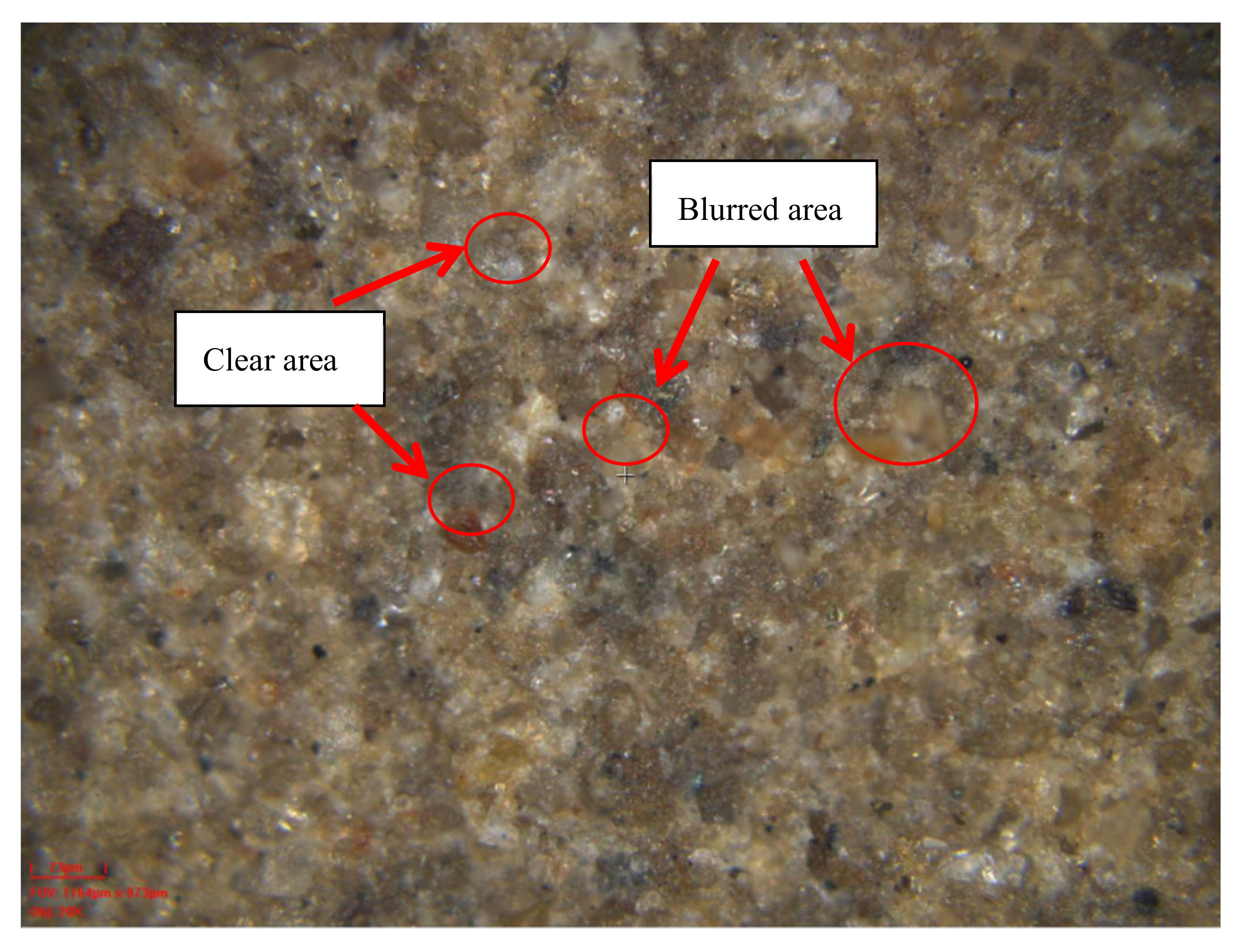
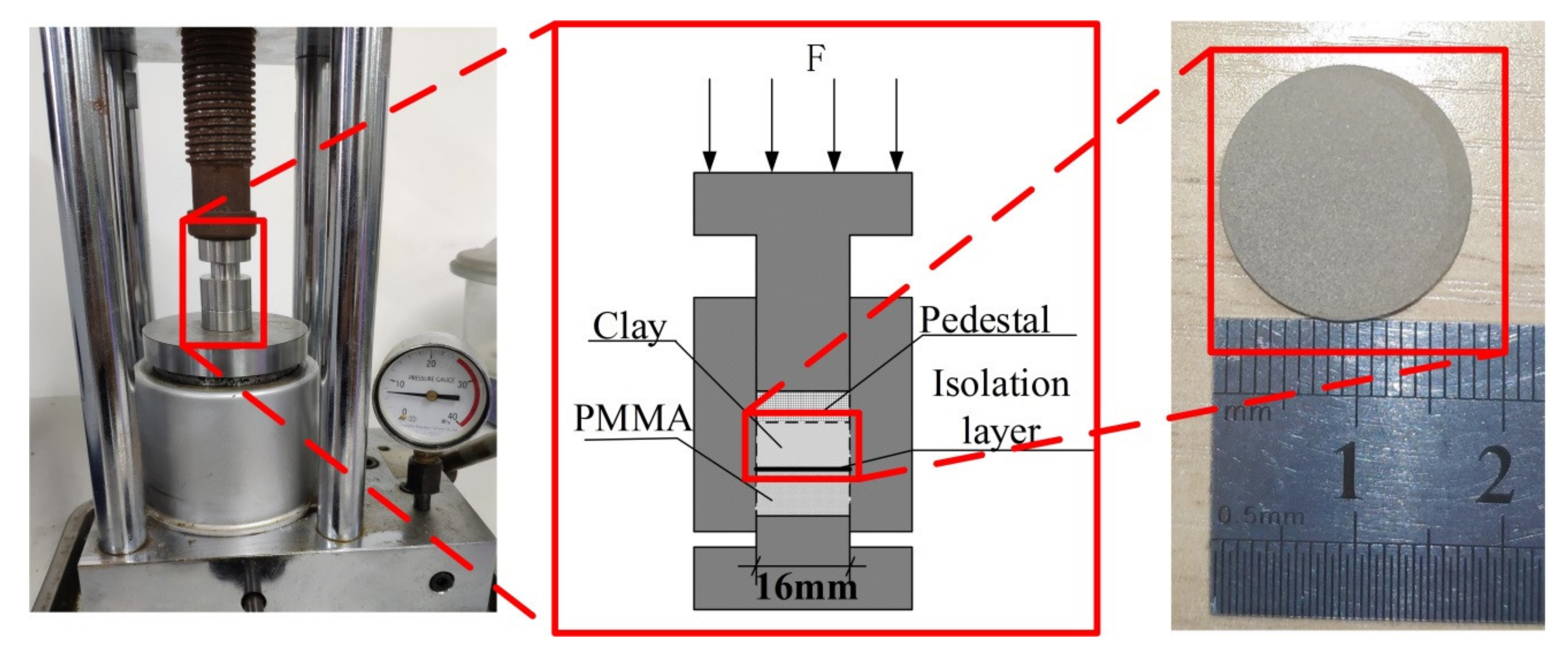
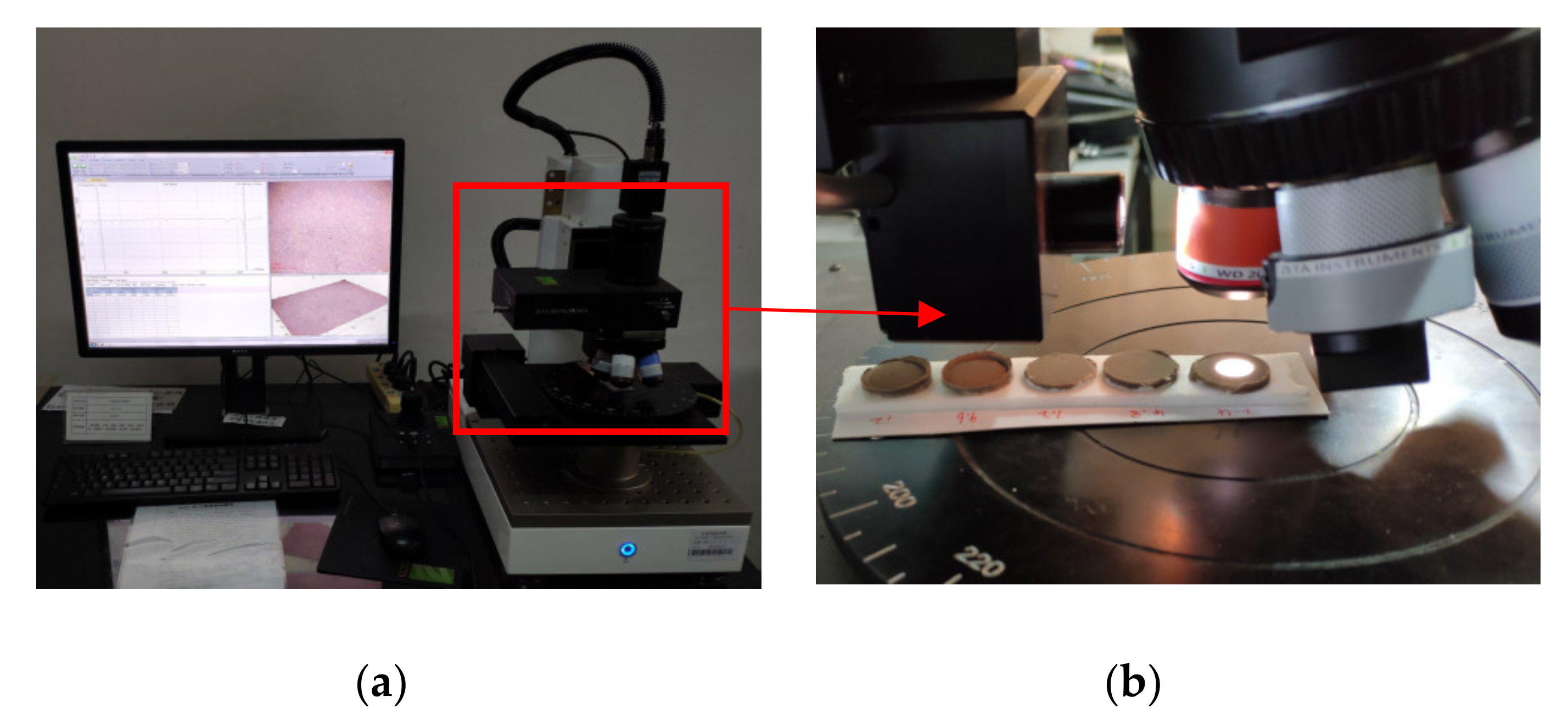
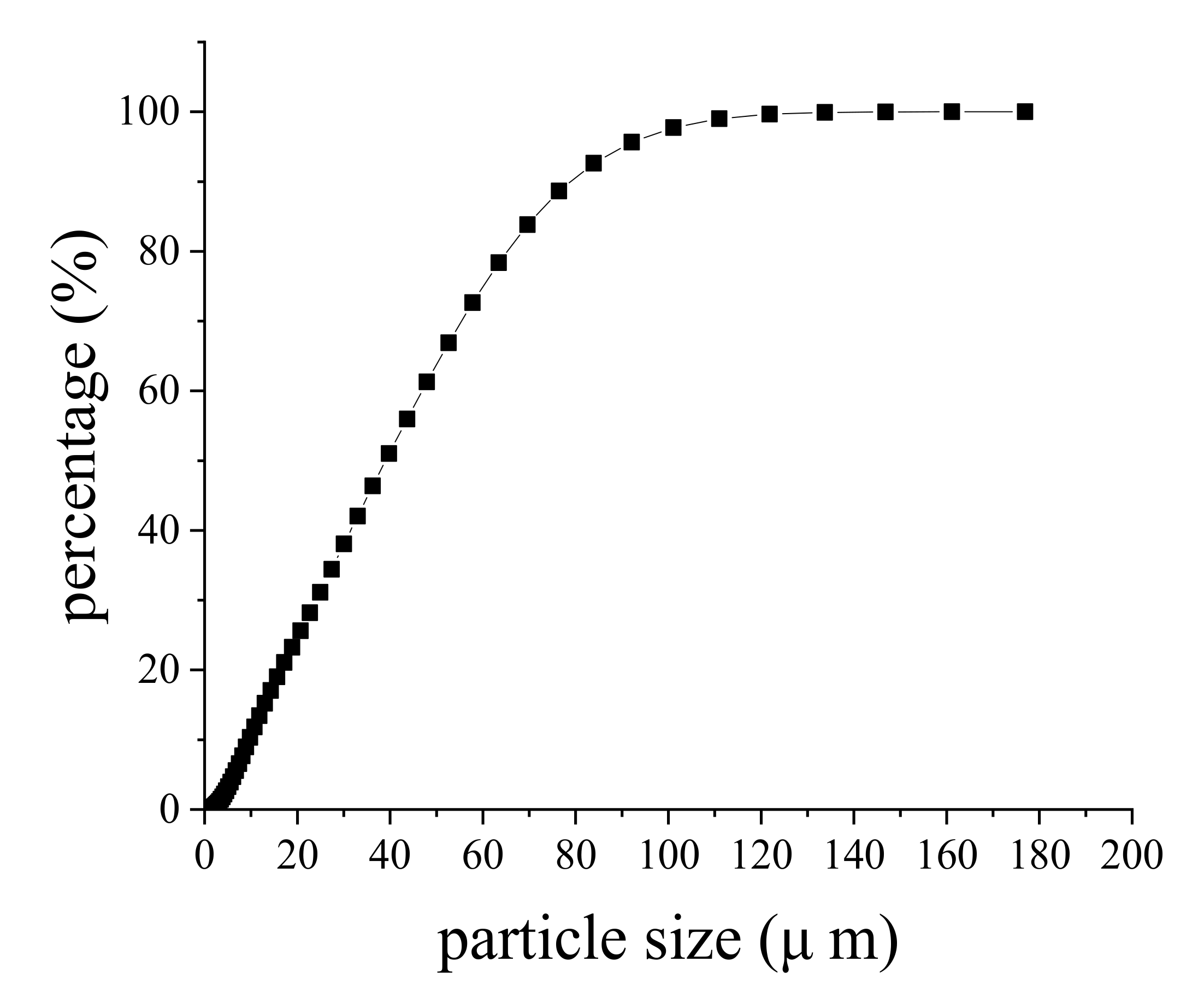
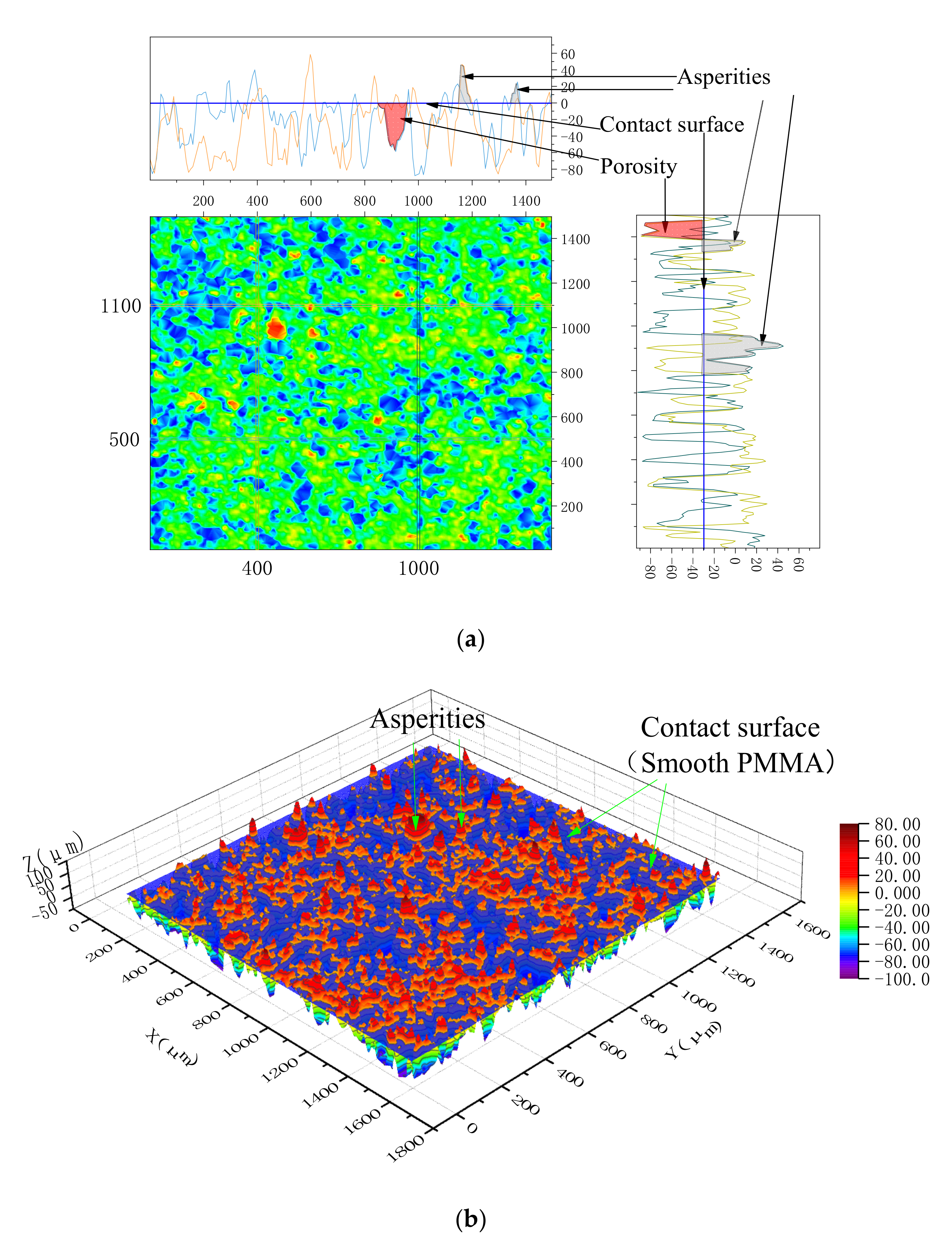
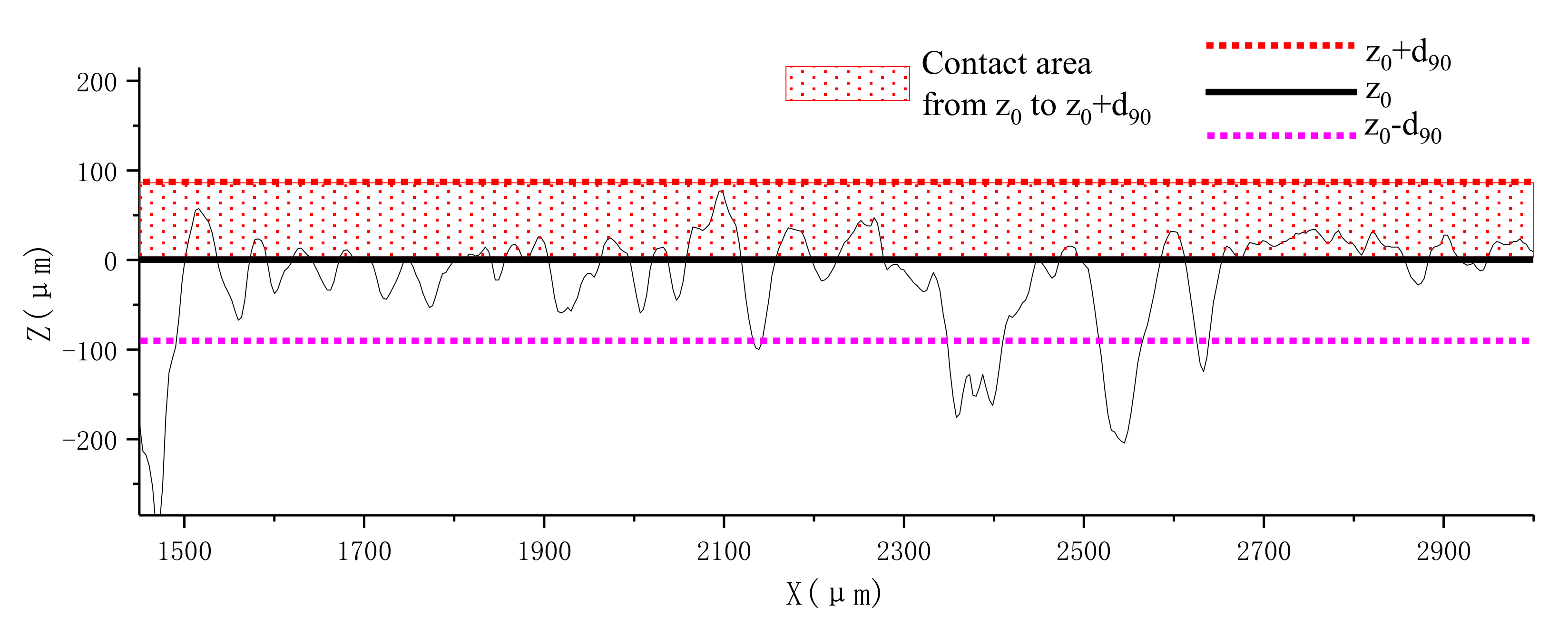
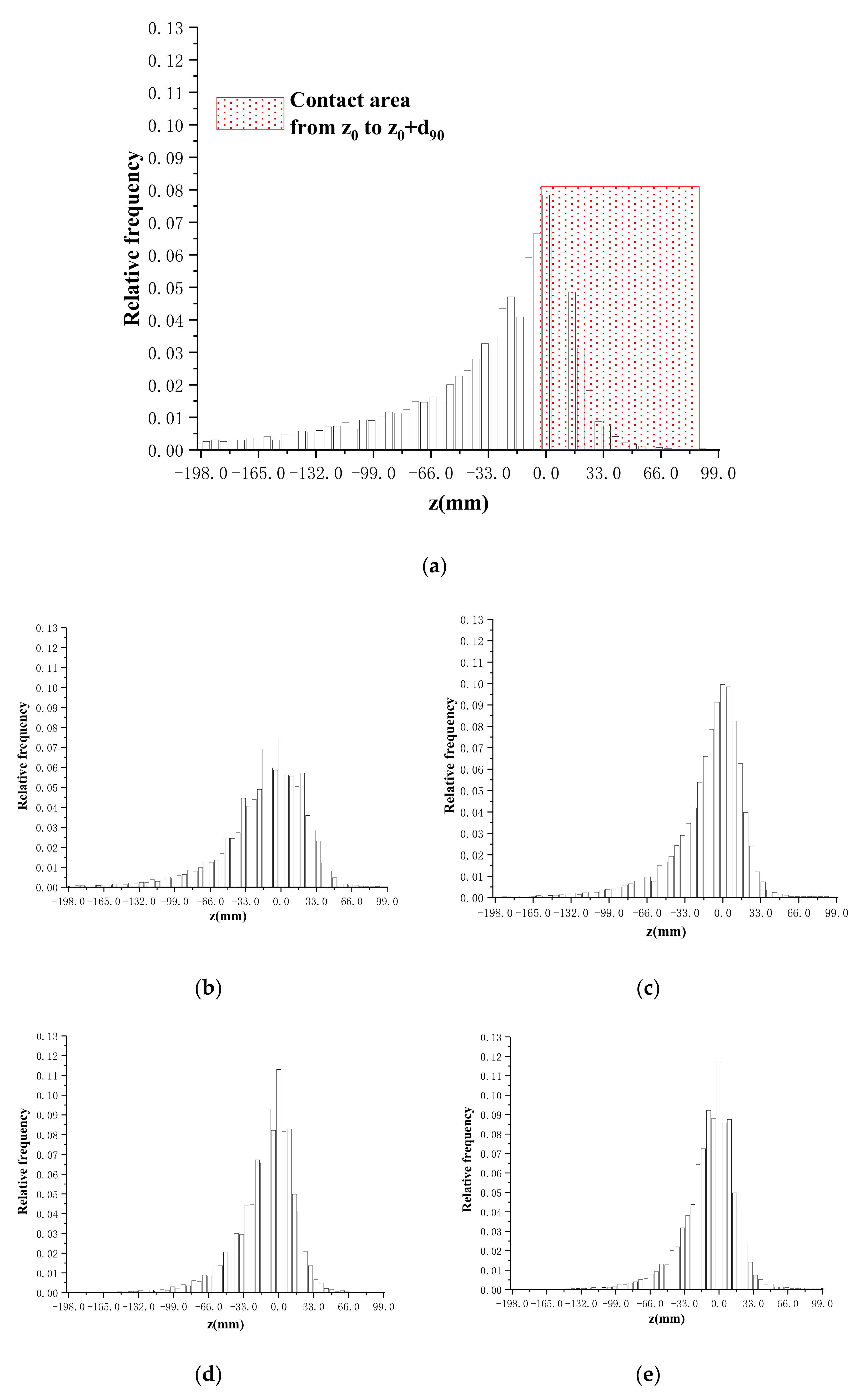



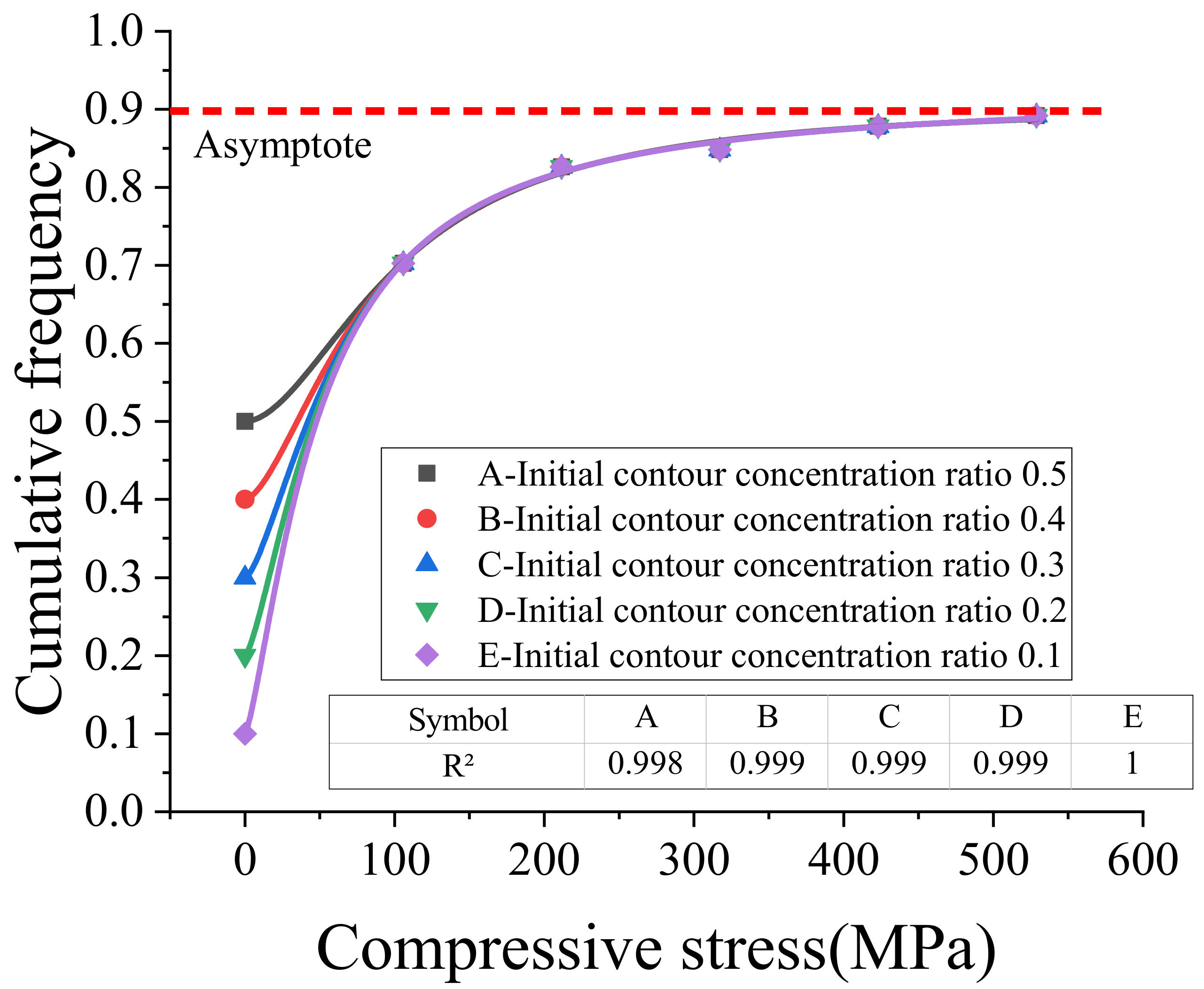
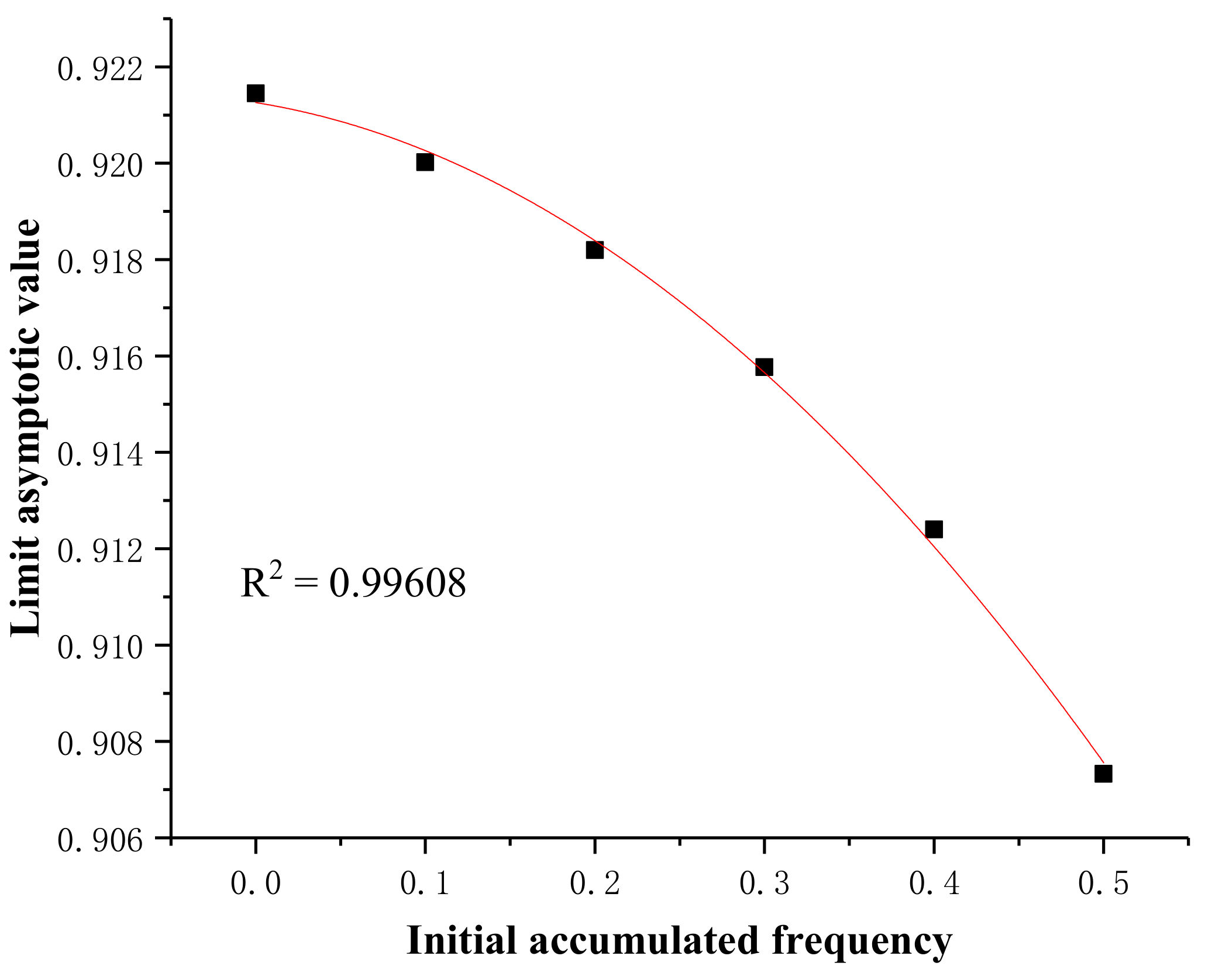
| ds (g/cm3) | Γ (kN/cm3) | W (%) | wL (%) | wp (%) | Ip (%) | Cohesion Force (kPa) | IFA (o) | Es1-2 (MPa) |
|---|---|---|---|---|---|---|---|---|
| 2.73 | 18.0 | 34.8 | 34.8 | 21.2 | 13.5 | 14.4 | 8.6 | 3.3 |
| Level | d10 | d25 | d50 | d75 | d90 |
|---|---|---|---|---|---|
| Particle size (μm) | 10.55 | 22.21 | 42.82 | 65.95 | 86.69 |
| Pressure (MPa) | Cumulative Frequency (CF) | ||||||||||
|---|---|---|---|---|---|---|---|---|---|---|---|
| z0 − d90 | z0 − d75 | z0 − d50 | z0 − d25 | z0 − d10 | z0 | z0 + d10 | z0 + d25 | z0 + d50 | z0 + d75 | z0 + d90 | |
| 106 | 0.280 | 0.332 | 0.414 | 0.496 | 0.556 | 0.608 | 0.662 | 0.7540 | 0.881 | 0.963 | 0.983 |
| 211 | 0.139 | 0.193 | 0.296 | 0.402 | 0.477 | 0.542 | 0.591 | 0.671 | 0.807 | 0.916 | 0.965 |
| 317 | 0.138 | 0.191 | 0.284 | 0.413 | 0.416 | 0.590 | 0.657 | 0.785 | 0.916 | 0.974 | 0.986 |
| 423 | 0.110 | 0.163 | 0.258 | 0.387 | 0.495 | 0.557 | 0.643 | 0.745 | 0.894 | 0.970 | 0.988 |
| 529 | 0.088 | 0.136 | 0.234 | 0.371 | 0.479 | 0.552 | 0.652 | 0.754 | 0.891 | 0.964 | 0.980 |
| Pressure (MPa) | Cumulative Frequency (CF) | ||
|---|---|---|---|
| (z0 + d90) − z0 | z0 − (z0 − d90) | (z0 + d90) − (z0 − d90) | |
| 106 | 0.375 | 0.328 | 0.703 |
| 211 | 0.423 | 0.403 | 0.826 |
| 317 | 0.396 | 0.452 | 0.848 |
| 423 | 0.431 | 0.447 | 0.878 |
| 529 | 0.428 | 0.464 | 0.892 |
| Initial Contour (z0 + d90) − (z0 − d90) CF | R2 | Limit Profile (z0 + d90) − (z0 − d90) CF |
|---|---|---|
| 0.1 | 1 | 0.920 ± 0.026 |
| 0.2 | 0.999 | 0.918 ± 0.025 |
| 0.3 | 0.999 | 0.916 ± 0.024 |
| 0.4 | 0.999 | 0.912 ± 0.022 |
| 0.5 | 0.998 | 0.907 ± 0.020 |
© 2020 by the authors. Licensee MDPI, Basel, Switzerland. This article is an open access article distributed under the terms and conditions of the Creative Commons Attribution (CC BY) license (http://creativecommons.org/licenses/by/4.0/).
Share and Cite
Yang, S.; Liu, J.; Xu, L.; Zhang, M.; Jeng, D.-S. A New Approach to Explore the Surface Profile of Clay Soil Using White Light Interferometry. Sensors 2020, 20, 3009. https://doi.org/10.3390/s20113009
Yang S, Liu J, Xu L, Zhang M, Jeng D-S. A New Approach to Explore the Surface Profile of Clay Soil Using White Light Interferometry. Sensors. 2020; 20(11):3009. https://doi.org/10.3390/s20113009
Chicago/Turabian StyleYang, Suchun, Junwei Liu, Longfei Xu, Mingyi Zhang, and Dong-Sheng Jeng. 2020. "A New Approach to Explore the Surface Profile of Clay Soil Using White Light Interferometry" Sensors 20, no. 11: 3009. https://doi.org/10.3390/s20113009






